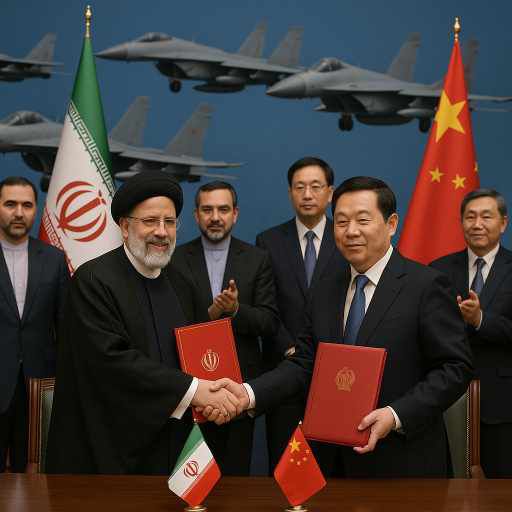Iran Buying J-10 from China: Is It Really Happening?
The geopolitical balance in the Middle East is shifting, and one critical headline emerging is Iran buying J-10 from China. As Tehran faces growing pressure from Israel, the U.S., and its Gulf rivals, its move to acquire the advanced J-10C fighter jets from China could reshape regional air power dynamics. But is this deal real, and what are the implications?
Iran’s Air Force Capabilities and Limitations
Iran’s current air fleet is outdated and largely composed of:
- American F-4 Phantom II and F-5 aircraft from the 1960s–70s
- Russian MiG-29 and Su-24 jets
- Domestic modifications with limited capability
With Israel fielding fifth-generation F-35s and the U.S. maintaining advanced air presence in the Persian Gulf, Iran urgently needs modernization. This explains growing speculation about Iran buying J-10 from China.
The J-10C: China’s Powerful Multirole Fighter
Technical Overview
The Chengdu J-10C is a 4.5-generation multirole fighter designed for air superiority and precision ground attacks. Its key features include:
- AESA radar (active electronically scanned array)
- Long-range PL-15 air-to-air missiles
- Modern electronic warfare systems
- WS-10B turbofan engine with high thrust-to-weight ratio
The J-10C offers compatibility with a wide variety of Chinese munitions and boasts reliable combat performance. For Iran, which faces international arms restrictions, this aircraft presents a viable and politically convenient option.
Why Is Iran Buying J-10 from China?
Access to Advanced Technology
Sanctions have long restricted Iran’s access to Western defense equipment. China, however, has emerged as an alternative supplier that is:
- Willing to bypass U.S.-led arms embargoes
- Actively seeking influence in the Middle East
- Offering competitive prices and technology
By buying J-10C jets, Iran could gain a modern air force platform without relying on Russian or Western suppliers.
Enhancing Deterrence Against Israel
Israel’s F-35I Adir jets currently enjoy unmatched air dominance in the region. If Iran deploys J-10Cs equipped with PL-15 missiles, it could challenge Israel’s aerial edge. These missiles reportedly have a range exceeding 200 km, potentially allowing Iran to target Israeli jets before they enter Iranian airspace.
Strengthening the Iran-China Alliance
Iran and China have deepened cooperation under their 25-year strategic partnership agreement, which includes:
- Oil exports from Iran to China
- Chinese infrastructure investment in Iranian ports and roads
- Potential military collaboration
Iran buying J-10 from China would represent a milestone in that military collaboration.
Is the Deal Confirmed?
While no official confirmation has been made, several reports suggest:
- Iran’s interest in the J-10C since at least 2021
- Advanced negotiations during recent China-Iran defense meetings
- Satellite images hinting at preparations for new aircraft in Iranian bases
If finalized, the deal would be among Iran’s most significant military acquisitions in decades.
Regional Reactions to Iran Buying J-10 from China
Israel and Gulf Countries
Israel is closely monitoring any sign of Iranian air capability improvements. Its military doctrine relies heavily on maintaining air superiority and preemptive strike capabilities. J-10C jets in Iranian hands could complicate Israeli calculations, especially if integrated with Iran’s radar and missile networks.
Gulf countries like Saudi Arabia and the UAE, although not directly threatened, would interpret this move as part of Iran’s regional assertiveness, likely prompting additional arms purchases and deeper defense ties with the West.
United States Perspective
The U.S. has consistently warned against arms transfers to Iran. Any confirmed delivery of J-10Cs could trigger new sanctions or military contingency planning. Washington may also pressure China to reconsider the deal under global non-proliferation norms, though with limited effectiveness.
Risks and Limitations
Despite the strategic benefits, Iran may face challenges including:
- Maintenance and spare parts for a high-tech fleet
- Integration with existing command systems
- Pilot training and technical adaptation
- Possible Israeli sabotage or airbase targeting
Iran would also need to deploy the jets in secure bases, possibly underground facilities, to avoid preemptive strikes.
Conclusion: A New Era in Iran’s Air Power?
The idea of Iran buying J-10 from China represents more than a weapons deal—it reflects a deeper geopolitical realignment. If realized, it could:
- Enhance Iran’s regional deterrence
- Challenge Israeli dominance in the skies
- Strengthen Sino-Iranian defense cooperation
While uncertainties remain, this potential acquisition marks a turning point in Middle Eastern airpower politics and Iran’s military modernization trajectory.

